Corporate Accounting of Retail Food Group
VerifiedAdded on 2023/06/12
|15
|3362
|110
AI Summary
This article provides an evaluation of the cash flow statement, income statement, and corporate income tax accounting of Retail Food Group. The analysis indicates that the company's tax expenses have increased over the years, which may affect its financial performance.
Contribute Materials
Your contribution can guide someone’s learning journey. Share your
documents today.
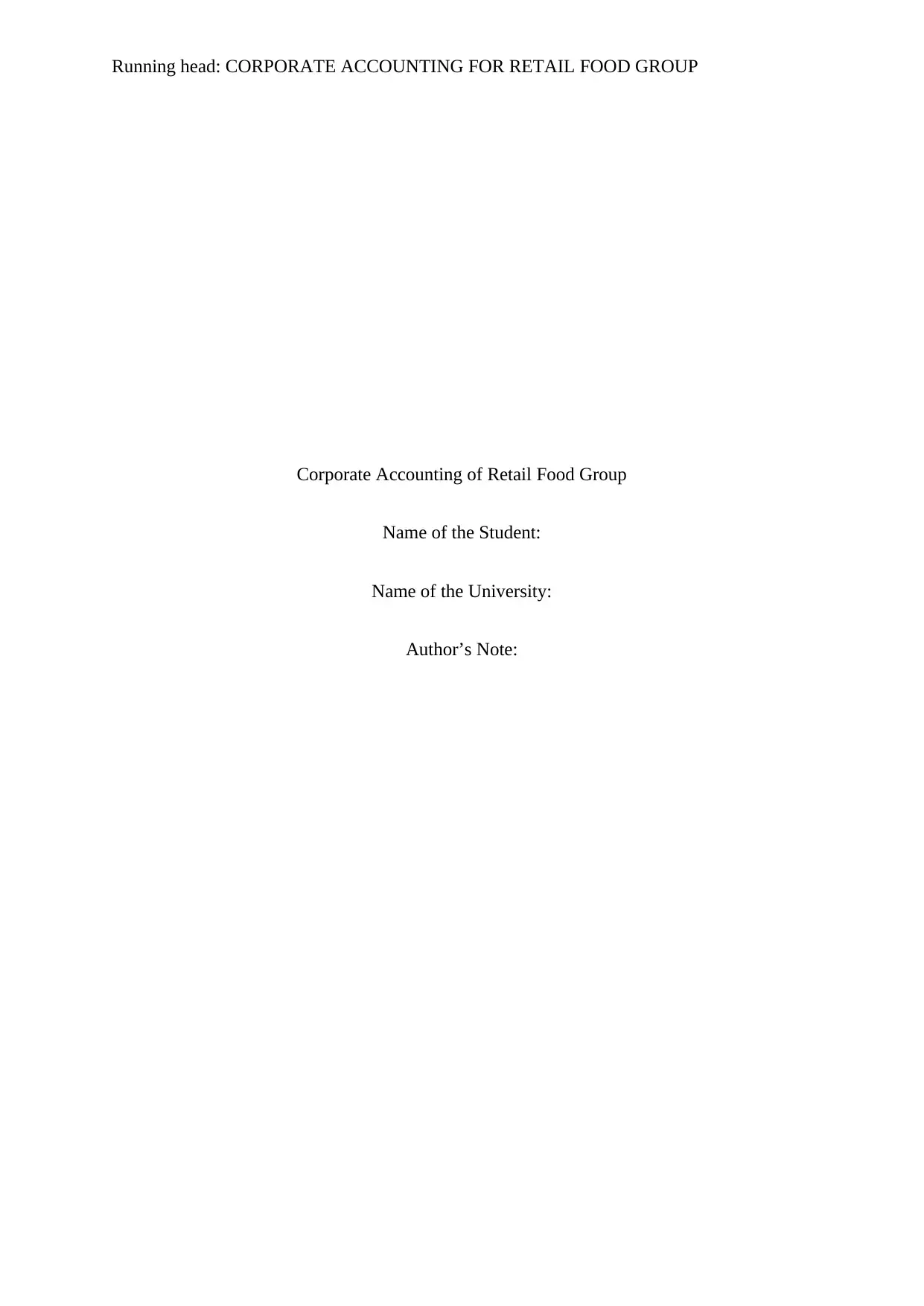
Running head: CORPORATE ACCOUNTING FOR RETAIL FOOD GROUP
Corporate Accounting of Retail Food Group
Name of the Student:
Name of the University:
Author’s Note:
Corporate Accounting of Retail Food Group
Name of the Student:
Name of the University:
Author’s Note:
Secure Best Marks with AI Grader
Need help grading? Try our AI Grader for instant feedback on your assignments.
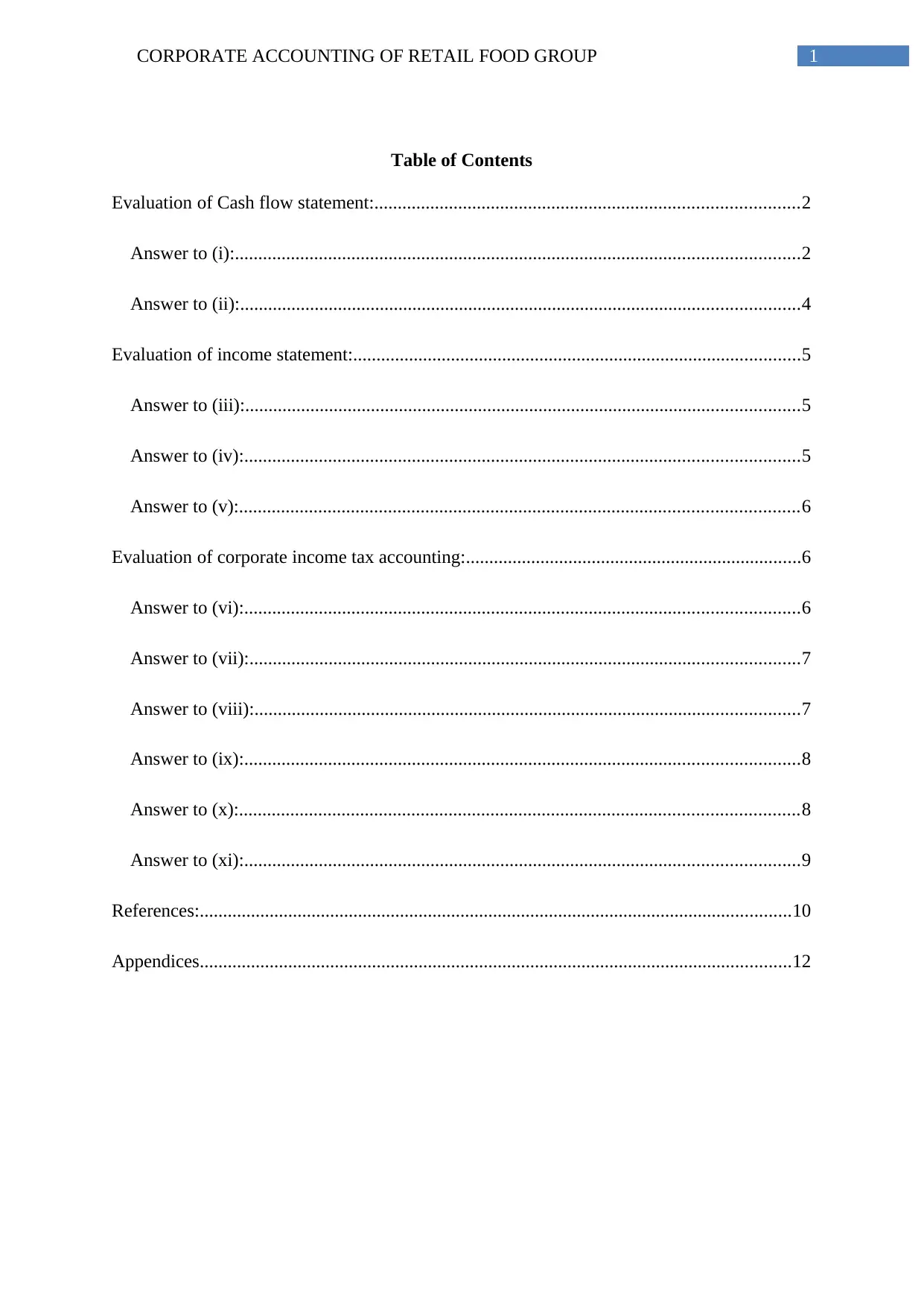
1CORPORATE ACCOUNTING OF RETAIL FOOD GROUP
Table of Contents
Evaluation of Cash flow statement:...........................................................................................2
Answer to (i):.........................................................................................................................2
Answer to (ii):........................................................................................................................4
Evaluation of income statement:................................................................................................5
Answer to (iii):.......................................................................................................................5
Answer to (iv):.......................................................................................................................5
Answer to (v):........................................................................................................................6
Evaluation of corporate income tax accounting:........................................................................6
Answer to (vi):.......................................................................................................................6
Answer to (vii):......................................................................................................................7
Answer to (viii):.....................................................................................................................7
Answer to (ix):.......................................................................................................................8
Answer to (x):........................................................................................................................8
Answer to (xi):.......................................................................................................................9
References:...............................................................................................................................10
Appendices...............................................................................................................................12
Table of Contents
Evaluation of Cash flow statement:...........................................................................................2
Answer to (i):.........................................................................................................................2
Answer to (ii):........................................................................................................................4
Evaluation of income statement:................................................................................................5
Answer to (iii):.......................................................................................................................5
Answer to (iv):.......................................................................................................................5
Answer to (v):........................................................................................................................6
Evaluation of corporate income tax accounting:........................................................................6
Answer to (vi):.......................................................................................................................6
Answer to (vii):......................................................................................................................7
Answer to (viii):.....................................................................................................................7
Answer to (ix):.......................................................................................................................8
Answer to (x):........................................................................................................................8
Answer to (xi):.......................................................................................................................9
References:...............................................................................................................................10
Appendices...............................................................................................................................12
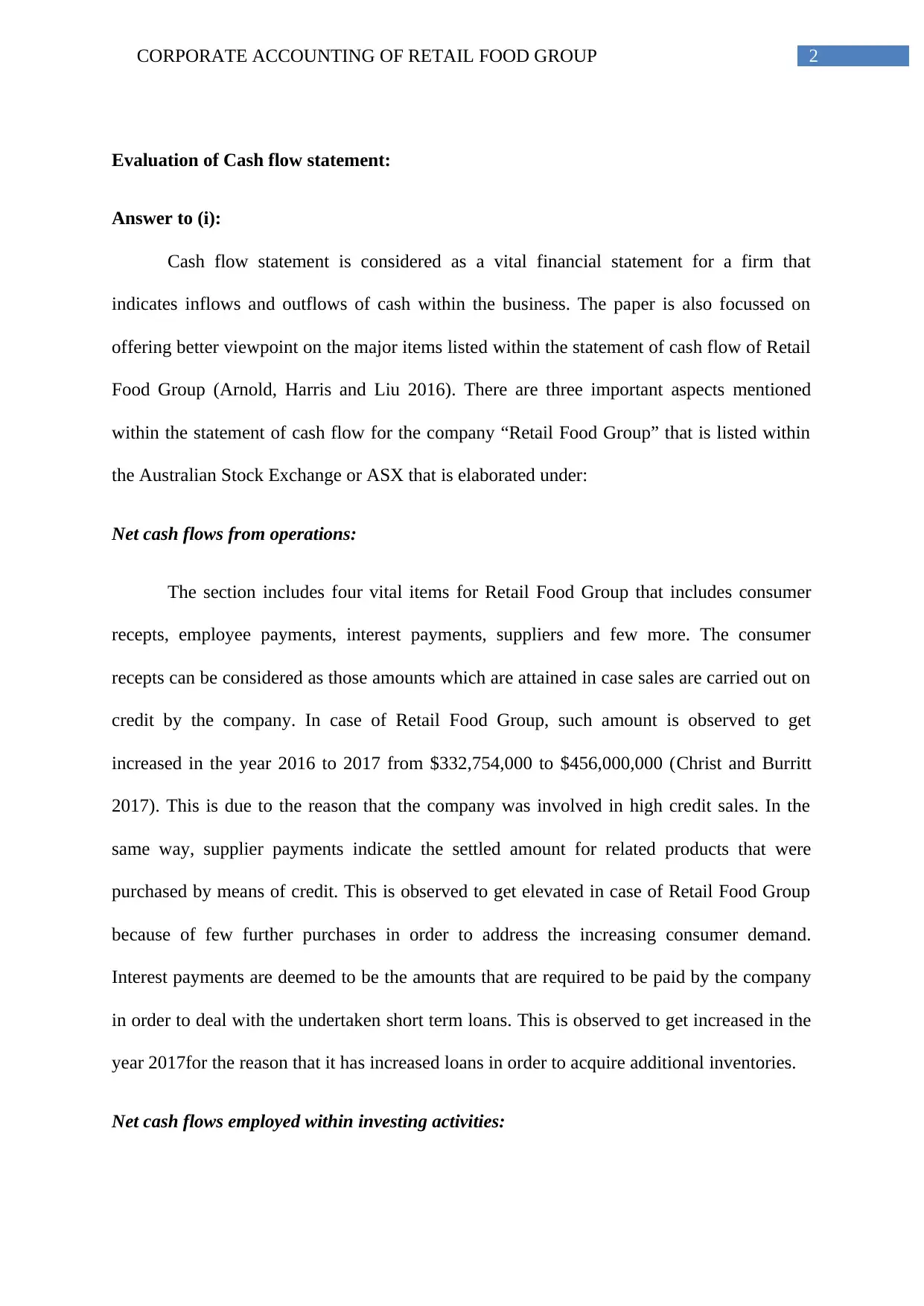
2CORPORATE ACCOUNTING OF RETAIL FOOD GROUP
Evaluation of Cash flow statement:
Answer to (i):
Cash flow statement is considered as a vital financial statement for a firm that
indicates inflows and outflows of cash within the business. The paper is also focussed on
offering better viewpoint on the major items listed within the statement of cash flow of Retail
Food Group (Arnold, Harris and Liu 2016). There are three important aspects mentioned
within the statement of cash flow for the company “Retail Food Group” that is listed within
the Australian Stock Exchange or ASX that is elaborated under:
Net cash flows from operations:
The section includes four vital items for Retail Food Group that includes consumer
recepts, employee payments, interest payments, suppliers and few more. The consumer
recepts can be considered as those amounts which are attained in case sales are carried out on
credit by the company. In case of Retail Food Group, such amount is observed to get
increased in the year 2016 to 2017 from $332,754,000 to $456,000,000 (Christ and Burritt
2017). This is due to the reason that the company was involved in high credit sales. In the
same way, supplier payments indicate the settled amount for related products that were
purchased by means of credit. This is observed to get elevated in case of Retail Food Group
because of few further purchases in order to address the increasing consumer demand.
Interest payments are deemed to be the amounts that are required to be paid by the company
in order to deal with the undertaken short term loans. This is observed to get increased in the
year 2017for the reason that it has increased loans in order to acquire additional inventories.
Net cash flows employed within investing activities:
Evaluation of Cash flow statement:
Answer to (i):
Cash flow statement is considered as a vital financial statement for a firm that
indicates inflows and outflows of cash within the business. The paper is also focussed on
offering better viewpoint on the major items listed within the statement of cash flow of Retail
Food Group (Arnold, Harris and Liu 2016). There are three important aspects mentioned
within the statement of cash flow for the company “Retail Food Group” that is listed within
the Australian Stock Exchange or ASX that is elaborated under:
Net cash flows from operations:
The section includes four vital items for Retail Food Group that includes consumer
recepts, employee payments, interest payments, suppliers and few more. The consumer
recepts can be considered as those amounts which are attained in case sales are carried out on
credit by the company. In case of Retail Food Group, such amount is observed to get
increased in the year 2016 to 2017 from $332,754,000 to $456,000,000 (Christ and Burritt
2017). This is due to the reason that the company was involved in high credit sales. In the
same way, supplier payments indicate the settled amount for related products that were
purchased by means of credit. This is observed to get elevated in case of Retail Food Group
because of few further purchases in order to address the increasing consumer demand.
Interest payments are deemed to be the amounts that are required to be paid by the company
in order to deal with the undertaken short term loans. This is observed to get increased in the
year 2017for the reason that it has increased loans in order to acquire additional inventories.
Net cash flows employed within investing activities:
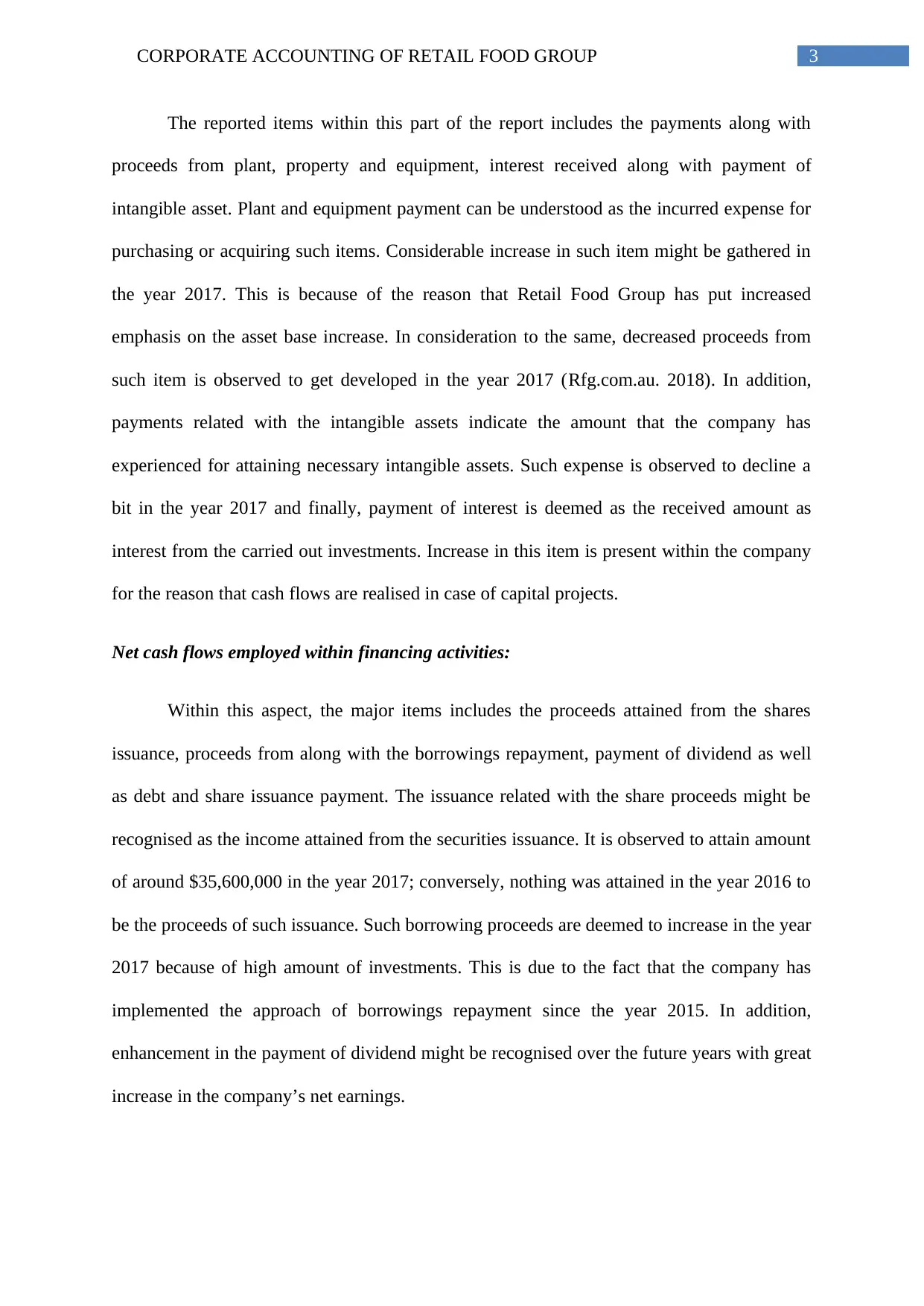
3CORPORATE ACCOUNTING OF RETAIL FOOD GROUP
The reported items within this part of the report includes the payments along with
proceeds from plant, property and equipment, interest received along with payment of
intangible asset. Plant and equipment payment can be understood as the incurred expense for
purchasing or acquiring such items. Considerable increase in such item might be gathered in
the year 2017. This is because of the reason that Retail Food Group has put increased
emphasis on the asset base increase. In consideration to the same, decreased proceeds from
such item is observed to get developed in the year 2017 (Rfg.com.au. 2018). In addition,
payments related with the intangible assets indicate the amount that the company has
experienced for attaining necessary intangible assets. Such expense is observed to decline a
bit in the year 2017 and finally, payment of interest is deemed as the received amount as
interest from the carried out investments. Increase in this item is present within the company
for the reason that cash flows are realised in case of capital projects.
Net cash flows employed within financing activities:
Within this aspect, the major items includes the proceeds attained from the shares
issuance, proceeds from along with the borrowings repayment, payment of dividend as well
as debt and share issuance payment. The issuance related with the share proceeds might be
recognised as the income attained from the securities issuance. It is observed to attain amount
of around $35,600,000 in the year 2017; conversely, nothing was attained in the year 2016 to
be the proceeds of such issuance. Such borrowing proceeds are deemed to increase in the year
2017 because of high amount of investments. This is due to the fact that the company has
implemented the approach of borrowings repayment since the year 2015. In addition,
enhancement in the payment of dividend might be recognised over the future years with great
increase in the company’s net earnings.
The reported items within this part of the report includes the payments along with
proceeds from plant, property and equipment, interest received along with payment of
intangible asset. Plant and equipment payment can be understood as the incurred expense for
purchasing or acquiring such items. Considerable increase in such item might be gathered in
the year 2017. This is because of the reason that Retail Food Group has put increased
emphasis on the asset base increase. In consideration to the same, decreased proceeds from
such item is observed to get developed in the year 2017 (Rfg.com.au. 2018). In addition,
payments related with the intangible assets indicate the amount that the company has
experienced for attaining necessary intangible assets. Such expense is observed to decline a
bit in the year 2017 and finally, payment of interest is deemed as the received amount as
interest from the carried out investments. Increase in this item is present within the company
for the reason that cash flows are realised in case of capital projects.
Net cash flows employed within financing activities:
Within this aspect, the major items includes the proceeds attained from the shares
issuance, proceeds from along with the borrowings repayment, payment of dividend as well
as debt and share issuance payment. The issuance related with the share proceeds might be
recognised as the income attained from the securities issuance. It is observed to attain amount
of around $35,600,000 in the year 2017; conversely, nothing was attained in the year 2016 to
be the proceeds of such issuance. Such borrowing proceeds are deemed to increase in the year
2017 because of high amount of investments. This is due to the fact that the company has
implemented the approach of borrowings repayment since the year 2015. In addition,
enhancement in the payment of dividend might be recognised over the future years with great
increase in the company’s net earnings.
Secure Best Marks with AI Grader
Need help grading? Try our AI Grader for instant feedback on your assignments.
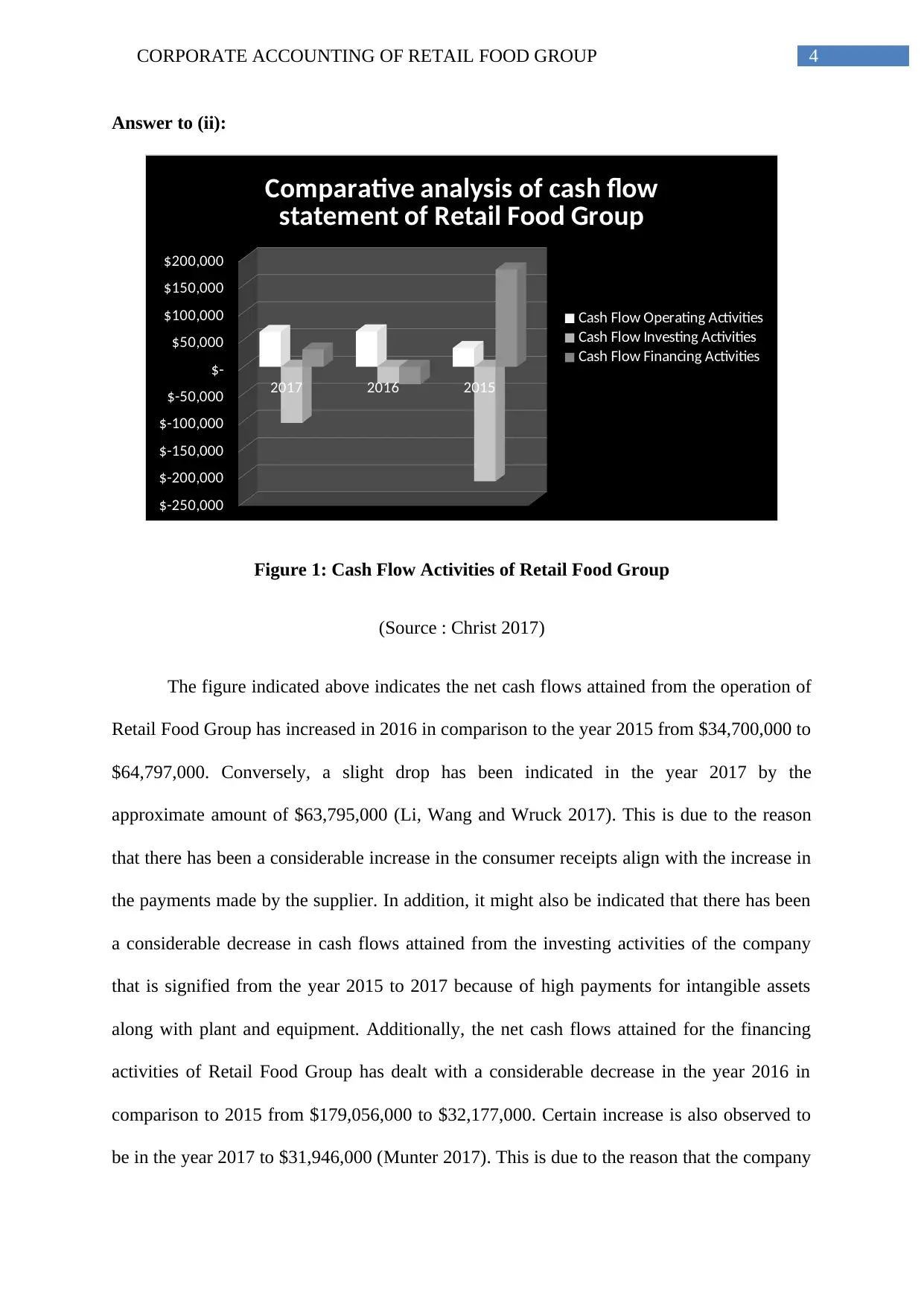
4CORPORATE ACCOUNTING OF RETAIL FOOD GROUP
Answer to (ii):
2017 2016 2015
$-250,000
$-200,000
$-150,000
$-100,000
$-50,000
$-
$50,000
$100,000
$150,000
$200,000
Comparative analysis of cash flow
statement of Retail Food Group
Cash Flow Operating Activities
Cash Flow Investing Activities
Cash Flow Financing Activities
Figure 1: Cash Flow Activities of Retail Food Group
(Source : Christ 2017)
The figure indicated above indicates the net cash flows attained from the operation of
Retail Food Group has increased in 2016 in comparison to the year 2015 from $34,700,000 to
$64,797,000. Conversely, a slight drop has been indicated in the year 2017 by the
approximate amount of $63,795,000 (Li, Wang and Wruck 2017). This is due to the reason
that there has been a considerable increase in the consumer receipts align with the increase in
the payments made by the supplier. In addition, it might also be indicated that there has been
a considerable decrease in cash flows attained from the investing activities of the company
that is signified from the year 2015 to 2017 because of high payments for intangible assets
along with plant and equipment. Additionally, the net cash flows attained for the financing
activities of Retail Food Group has dealt with a considerable decrease in the year 2016 in
comparison to 2015 from $179,056,000 to $32,177,000. Certain increase is also observed to
be in the year 2017 to $31,946,000 (Munter 2017). This is due to the reason that the company
Answer to (ii):
2017 2016 2015
$-250,000
$-200,000
$-150,000
$-100,000
$-50,000
$-
$50,000
$100,000
$150,000
$200,000
Comparative analysis of cash flow
statement of Retail Food Group
Cash Flow Operating Activities
Cash Flow Investing Activities
Cash Flow Financing Activities
Figure 1: Cash Flow Activities of Retail Food Group
(Source : Christ 2017)
The figure indicated above indicates the net cash flows attained from the operation of
Retail Food Group has increased in 2016 in comparison to the year 2015 from $34,700,000 to
$64,797,000. Conversely, a slight drop has been indicated in the year 2017 by the
approximate amount of $63,795,000 (Li, Wang and Wruck 2017). This is due to the reason
that there has been a considerable increase in the consumer receipts align with the increase in
the payments made by the supplier. In addition, it might also be indicated that there has been
a considerable decrease in cash flows attained from the investing activities of the company
that is signified from the year 2015 to 2017 because of high payments for intangible assets
along with plant and equipment. Additionally, the net cash flows attained for the financing
activities of Retail Food Group has dealt with a considerable decrease in the year 2016 in
comparison to 2015 from $179,056,000 to $32,177,000. Certain increase is also observed to
be in the year 2017 to $31,946,000 (Munter 2017). This is due to the reason that the company
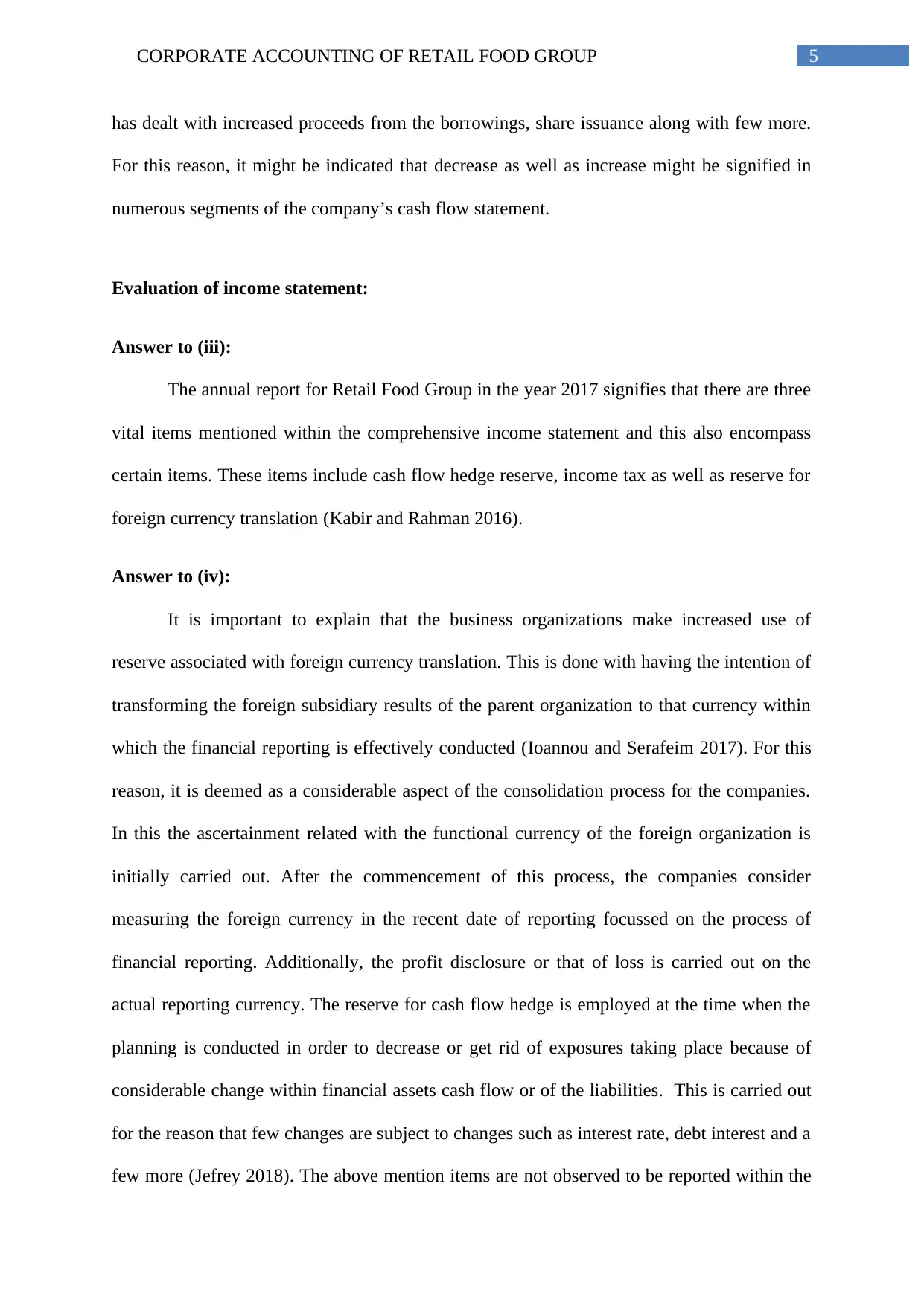
5CORPORATE ACCOUNTING OF RETAIL FOOD GROUP
has dealt with increased proceeds from the borrowings, share issuance along with few more.
For this reason, it might be indicated that decrease as well as increase might be signified in
numerous segments of the company’s cash flow statement.
Evaluation of income statement:
Answer to (iii):
The annual report for Retail Food Group in the year 2017 signifies that there are three
vital items mentioned within the comprehensive income statement and this also encompass
certain items. These items include cash flow hedge reserve, income tax as well as reserve for
foreign currency translation (Kabir and Rahman 2016).
Answer to (iv):
It is important to explain that the business organizations make increased use of
reserve associated with foreign currency translation. This is done with having the intention of
transforming the foreign subsidiary results of the parent organization to that currency within
which the financial reporting is effectively conducted (Ioannou and Serafeim 2017). For this
reason, it is deemed as a considerable aspect of the consolidation process for the companies.
In this the ascertainment related with the functional currency of the foreign organization is
initially carried out. After the commencement of this process, the companies consider
measuring the foreign currency in the recent date of reporting focussed on the process of
financial reporting. Additionally, the profit disclosure or that of loss is carried out on the
actual reporting currency. The reserve for cash flow hedge is employed at the time when the
planning is conducted in order to decrease or get rid of exposures taking place because of
considerable change within financial assets cash flow or of the liabilities. This is carried out
for the reason that few changes are subject to changes such as interest rate, debt interest and a
few more (Jefrey 2018). The above mention items are not observed to be reported within the
has dealt with increased proceeds from the borrowings, share issuance along with few more.
For this reason, it might be indicated that decrease as well as increase might be signified in
numerous segments of the company’s cash flow statement.
Evaluation of income statement:
Answer to (iii):
The annual report for Retail Food Group in the year 2017 signifies that there are three
vital items mentioned within the comprehensive income statement and this also encompass
certain items. These items include cash flow hedge reserve, income tax as well as reserve for
foreign currency translation (Kabir and Rahman 2016).
Answer to (iv):
It is important to explain that the business organizations make increased use of
reserve associated with foreign currency translation. This is done with having the intention of
transforming the foreign subsidiary results of the parent organization to that currency within
which the financial reporting is effectively conducted (Ioannou and Serafeim 2017). For this
reason, it is deemed as a considerable aspect of the consolidation process for the companies.
In this the ascertainment related with the functional currency of the foreign organization is
initially carried out. After the commencement of this process, the companies consider
measuring the foreign currency in the recent date of reporting focussed on the process of
financial reporting. Additionally, the profit disclosure or that of loss is carried out on the
actual reporting currency. The reserve for cash flow hedge is employed at the time when the
planning is conducted in order to decrease or get rid of exposures taking place because of
considerable change within financial assets cash flow or of the liabilities. This is carried out
for the reason that few changes are subject to changes such as interest rate, debt interest and a
few more (Jefrey 2018). The above mention items are not observed to be reported within the
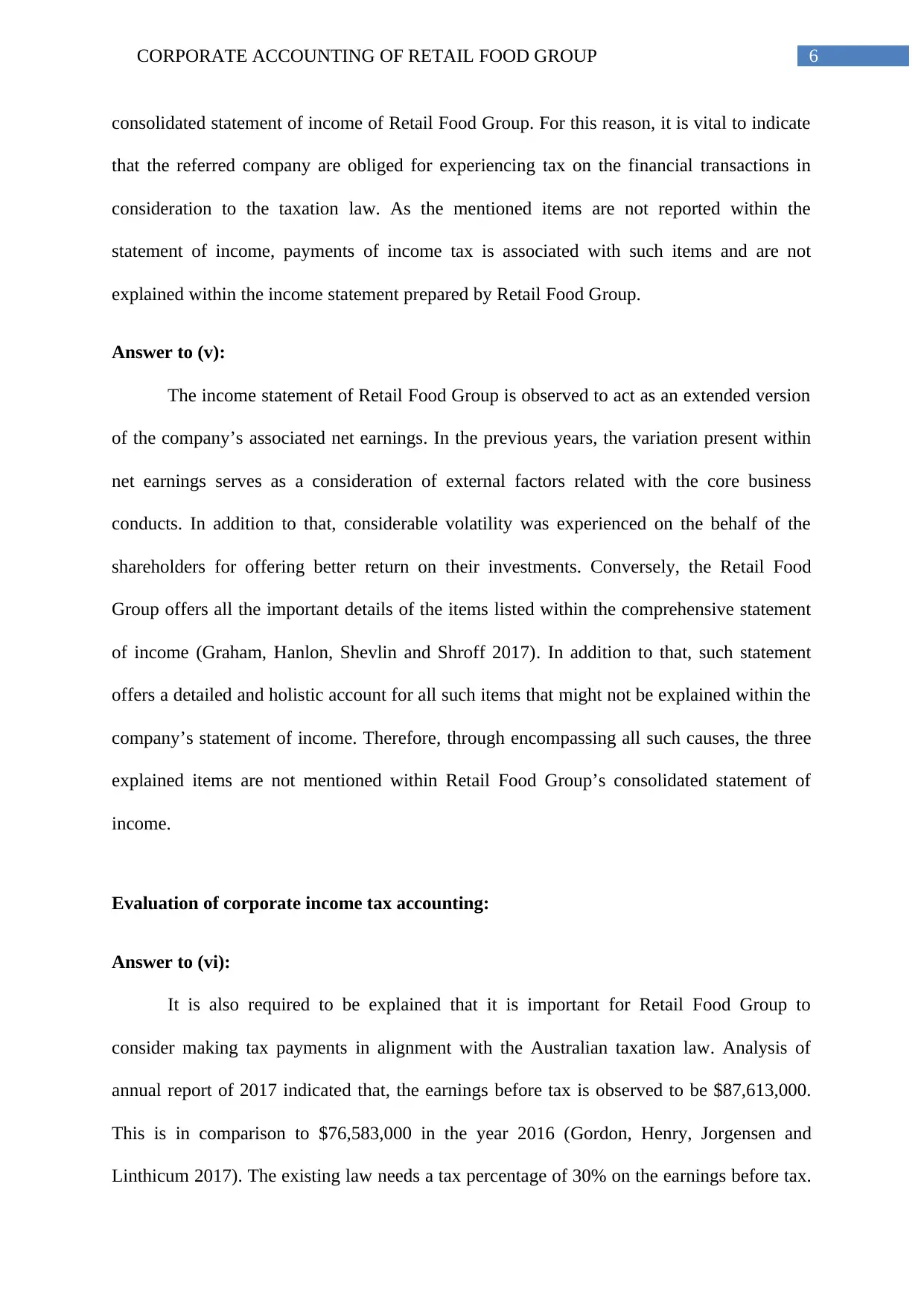
6CORPORATE ACCOUNTING OF RETAIL FOOD GROUP
consolidated statement of income of Retail Food Group. For this reason, it is vital to indicate
that the referred company are obliged for experiencing tax on the financial transactions in
consideration to the taxation law. As the mentioned items are not reported within the
statement of income, payments of income tax is associated with such items and are not
explained within the income statement prepared by Retail Food Group.
Answer to (v):
The income statement of Retail Food Group is observed to act as an extended version
of the company’s associated net earnings. In the previous years, the variation present within
net earnings serves as a consideration of external factors related with the core business
conducts. In addition to that, considerable volatility was experienced on the behalf of the
shareholders for offering better return on their investments. Conversely, the Retail Food
Group offers all the important details of the items listed within the comprehensive statement
of income (Graham, Hanlon, Shevlin and Shroff 2017). In addition to that, such statement
offers a detailed and holistic account for all such items that might not be explained within the
company’s statement of income. Therefore, through encompassing all such causes, the three
explained items are not mentioned within Retail Food Group’s consolidated statement of
income.
Evaluation of corporate income tax accounting:
Answer to (vi):
It is also required to be explained that it is important for Retail Food Group to
consider making tax payments in alignment with the Australian taxation law. Analysis of
annual report of 2017 indicated that, the earnings before tax is observed to be $87,613,000.
This is in comparison to $76,583,000 in the year 2016 (Gordon, Henry, Jorgensen and
Linthicum 2017). The existing law needs a tax percentage of 30% on the earnings before tax.
consolidated statement of income of Retail Food Group. For this reason, it is vital to indicate
that the referred company are obliged for experiencing tax on the financial transactions in
consideration to the taxation law. As the mentioned items are not reported within the
statement of income, payments of income tax is associated with such items and are not
explained within the income statement prepared by Retail Food Group.
Answer to (v):
The income statement of Retail Food Group is observed to act as an extended version
of the company’s associated net earnings. In the previous years, the variation present within
net earnings serves as a consideration of external factors related with the core business
conducts. In addition to that, considerable volatility was experienced on the behalf of the
shareholders for offering better return on their investments. Conversely, the Retail Food
Group offers all the important details of the items listed within the comprehensive statement
of income (Graham, Hanlon, Shevlin and Shroff 2017). In addition to that, such statement
offers a detailed and holistic account for all such items that might not be explained within the
company’s statement of income. Therefore, through encompassing all such causes, the three
explained items are not mentioned within Retail Food Group’s consolidated statement of
income.
Evaluation of corporate income tax accounting:
Answer to (vi):
It is also required to be explained that it is important for Retail Food Group to
consider making tax payments in alignment with the Australian taxation law. Analysis of
annual report of 2017 indicated that, the earnings before tax is observed to be $87,613,000.
This is in comparison to $76,583,000 in the year 2016 (Gordon, Henry, Jorgensen and
Linthicum 2017). The existing law needs a tax percentage of 30% on the earnings before tax.
Paraphrase This Document
Need a fresh take? Get an instant paraphrase of this document with our AI Paraphraser
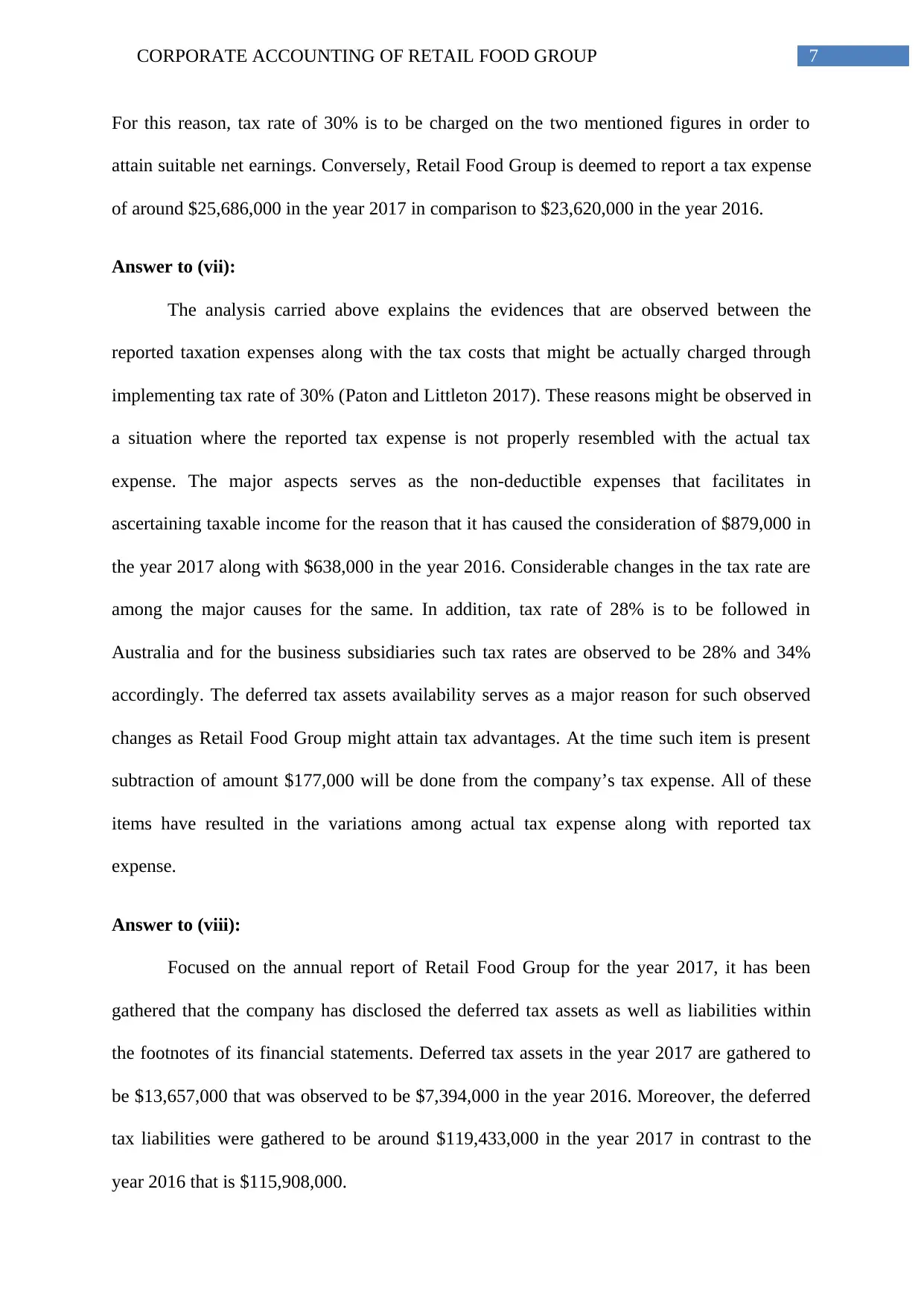
7CORPORATE ACCOUNTING OF RETAIL FOOD GROUP
For this reason, tax rate of 30% is to be charged on the two mentioned figures in order to
attain suitable net earnings. Conversely, Retail Food Group is deemed to report a tax expense
of around $25,686,000 in the year 2017 in comparison to $23,620,000 in the year 2016.
Answer to (vii):
The analysis carried above explains the evidences that are observed between the
reported taxation expenses along with the tax costs that might be actually charged through
implementing tax rate of 30% (Paton and Littleton 2017). These reasons might be observed in
a situation where the reported tax expense is not properly resembled with the actual tax
expense. The major aspects serves as the non-deductible expenses that facilitates in
ascertaining taxable income for the reason that it has caused the consideration of $879,000 in
the year 2017 along with $638,000 in the year 2016. Considerable changes in the tax rate are
among the major causes for the same. In addition, tax rate of 28% is to be followed in
Australia and for the business subsidiaries such tax rates are observed to be 28% and 34%
accordingly. The deferred tax assets availability serves as a major reason for such observed
changes as Retail Food Group might attain tax advantages. At the time such item is present
subtraction of amount $177,000 will be done from the company’s tax expense. All of these
items have resulted in the variations among actual tax expense along with reported tax
expense.
Answer to (viii):
Focused on the annual report of Retail Food Group for the year 2017, it has been
gathered that the company has disclosed the deferred tax assets as well as liabilities within
the footnotes of its financial statements. Deferred tax assets in the year 2017 are gathered to
be $13,657,000 that was observed to be $7,394,000 in the year 2016. Moreover, the deferred
tax liabilities were gathered to be around $119,433,000 in the year 2017 in contrast to the
year 2016 that is $115,908,000.
For this reason, tax rate of 30% is to be charged on the two mentioned figures in order to
attain suitable net earnings. Conversely, Retail Food Group is deemed to report a tax expense
of around $25,686,000 in the year 2017 in comparison to $23,620,000 in the year 2016.
Answer to (vii):
The analysis carried above explains the evidences that are observed between the
reported taxation expenses along with the tax costs that might be actually charged through
implementing tax rate of 30% (Paton and Littleton 2017). These reasons might be observed in
a situation where the reported tax expense is not properly resembled with the actual tax
expense. The major aspects serves as the non-deductible expenses that facilitates in
ascertaining taxable income for the reason that it has caused the consideration of $879,000 in
the year 2017 along with $638,000 in the year 2016. Considerable changes in the tax rate are
among the major causes for the same. In addition, tax rate of 28% is to be followed in
Australia and for the business subsidiaries such tax rates are observed to be 28% and 34%
accordingly. The deferred tax assets availability serves as a major reason for such observed
changes as Retail Food Group might attain tax advantages. At the time such item is present
subtraction of amount $177,000 will be done from the company’s tax expense. All of these
items have resulted in the variations among actual tax expense along with reported tax
expense.
Answer to (viii):
Focused on the annual report of Retail Food Group for the year 2017, it has been
gathered that the company has disclosed the deferred tax assets as well as liabilities within
the footnotes of its financial statements. Deferred tax assets in the year 2017 are gathered to
be $13,657,000 that was observed to be $7,394,000 in the year 2016. Moreover, the deferred
tax liabilities were gathered to be around $119,433,000 in the year 2017 in contrast to the
year 2016 that is $115,908,000.
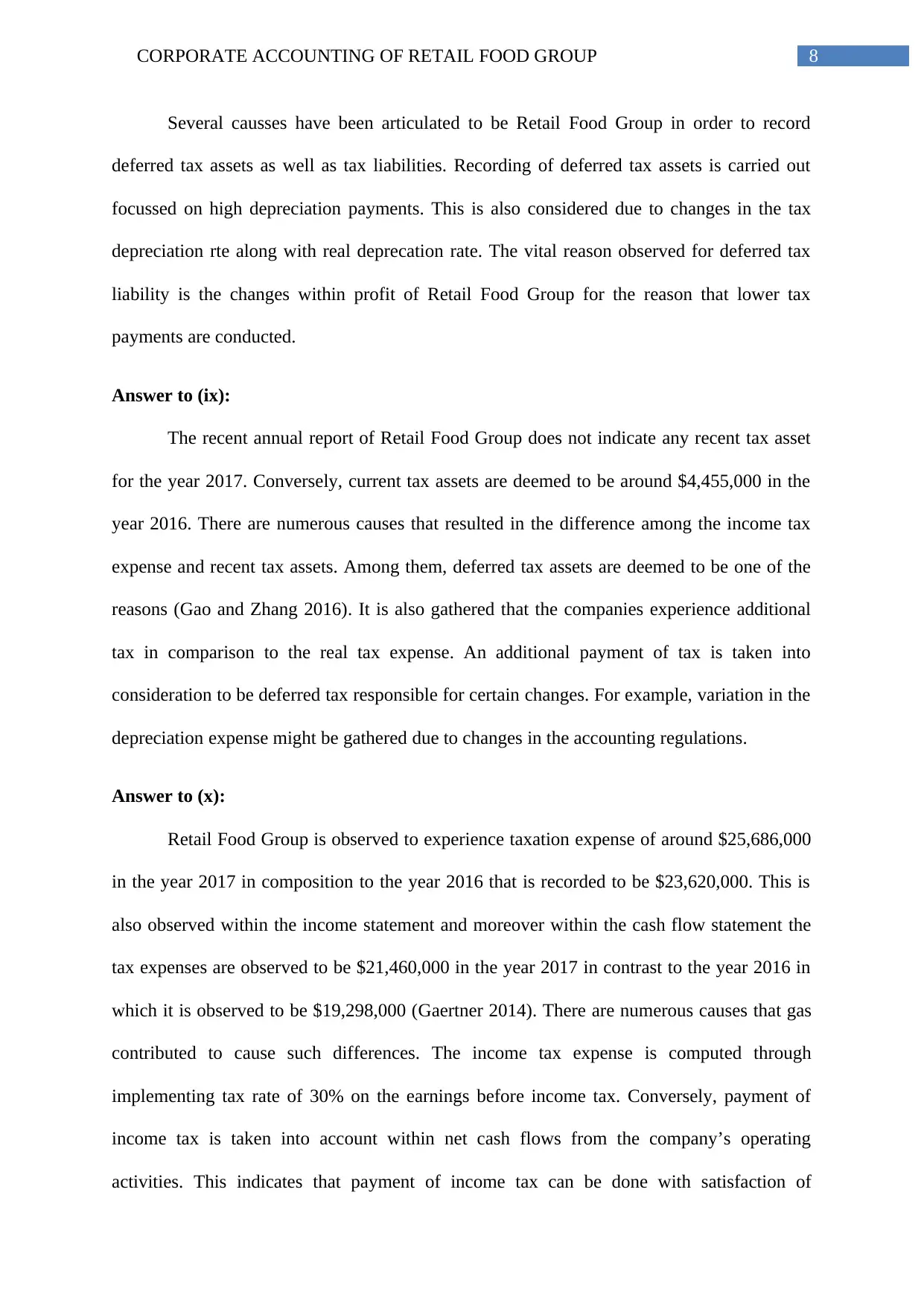
8CORPORATE ACCOUNTING OF RETAIL FOOD GROUP
Several causses have been articulated to be Retail Food Group in order to record
deferred tax assets as well as tax liabilities. Recording of deferred tax assets is carried out
focussed on high depreciation payments. This is also considered due to changes in the tax
depreciation rte along with real deprecation rate. The vital reason observed for deferred tax
liability is the changes within profit of Retail Food Group for the reason that lower tax
payments are conducted.
Answer to (ix):
The recent annual report of Retail Food Group does not indicate any recent tax asset
for the year 2017. Conversely, current tax assets are deemed to be around $4,455,000 in the
year 2016. There are numerous causes that resulted in the difference among the income tax
expense and recent tax assets. Among them, deferred tax assets are deemed to be one of the
reasons (Gao and Zhang 2016). It is also gathered that the companies experience additional
tax in comparison to the real tax expense. An additional payment of tax is taken into
consideration to be deferred tax responsible for certain changes. For example, variation in the
depreciation expense might be gathered due to changes in the accounting regulations.
Answer to (x):
Retail Food Group is observed to experience taxation expense of around $25,686,000
in the year 2017 in composition to the year 2016 that is recorded to be $23,620,000. This is
also observed within the income statement and moreover within the cash flow statement the
tax expenses are observed to be $21,460,000 in the year 2017 in contrast to the year 2016 in
which it is observed to be $19,298,000 (Gaertner 2014). There are numerous causes that gas
contributed to cause such differences. The income tax expense is computed through
implementing tax rate of 30% on the earnings before income tax. Conversely, payment of
income tax is taken into account within net cash flows from the company’s operating
activities. This indicates that payment of income tax can be done with satisfaction of
Several causses have been articulated to be Retail Food Group in order to record
deferred tax assets as well as tax liabilities. Recording of deferred tax assets is carried out
focussed on high depreciation payments. This is also considered due to changes in the tax
depreciation rte along with real deprecation rate. The vital reason observed for deferred tax
liability is the changes within profit of Retail Food Group for the reason that lower tax
payments are conducted.
Answer to (ix):
The recent annual report of Retail Food Group does not indicate any recent tax asset
for the year 2017. Conversely, current tax assets are deemed to be around $4,455,000 in the
year 2016. There are numerous causes that resulted in the difference among the income tax
expense and recent tax assets. Among them, deferred tax assets are deemed to be one of the
reasons (Gao and Zhang 2016). It is also gathered that the companies experience additional
tax in comparison to the real tax expense. An additional payment of tax is taken into
consideration to be deferred tax responsible for certain changes. For example, variation in the
depreciation expense might be gathered due to changes in the accounting regulations.
Answer to (x):
Retail Food Group is observed to experience taxation expense of around $25,686,000
in the year 2017 in composition to the year 2016 that is recorded to be $23,620,000. This is
also observed within the income statement and moreover within the cash flow statement the
tax expenses are observed to be $21,460,000 in the year 2017 in contrast to the year 2016 in
which it is observed to be $19,298,000 (Gaertner 2014). There are numerous causes that gas
contributed to cause such differences. The income tax expense is computed through
implementing tax rate of 30% on the earnings before income tax. Conversely, payment of
income tax is taken into account within net cash flows from the company’s operating
activities. This indicates that payment of income tax can be done with satisfaction of

9CORPORATE ACCOUNTING OF RETAIL FOOD GROUP
remaining obligations of the firm. The income tax expense for the present year is observed
within the statement of income for the current financial year. Conversely, for taxation
expenses within the statement of cash flow, the tax payment for previous year or the future
year payment of tax is considered. Focussing on all these causes, the major difference can be
perceived to be within the taxation expenses.
Answer to (xi):
Focussed on the above analysis it can be analysed that there are no surprising or
confusing item that can be considered within the taxation treatment of Retail Food Group as
it has carried out tax operations in compliance with the Australian taxation law. Considering
the same, it might be an interesting aspect in observing the manner in which Retail Food
Group has considered taxation expense (Darrat, Gray, Park and Wu 2016). The accessibility
of deferred tax assets serves as an important reason for such differences and the company can
attain tax advantages. For this reason, after proper analysis of the tax based accounting of
Retail Food Group, a detailed knowledge can be attained based on the manner of conducting
tax based operations in the company.
remaining obligations of the firm. The income tax expense for the present year is observed
within the statement of income for the current financial year. Conversely, for taxation
expenses within the statement of cash flow, the tax payment for previous year or the future
year payment of tax is considered. Focussing on all these causes, the major difference can be
perceived to be within the taxation expenses.
Answer to (xi):
Focussed on the above analysis it can be analysed that there are no surprising or
confusing item that can be considered within the taxation treatment of Retail Food Group as
it has carried out tax operations in compliance with the Australian taxation law. Considering
the same, it might be an interesting aspect in observing the manner in which Retail Food
Group has considered taxation expense (Darrat, Gray, Park and Wu 2016). The accessibility
of deferred tax assets serves as an important reason for such differences and the company can
attain tax advantages. For this reason, after proper analysis of the tax based accounting of
Retail Food Group, a detailed knowledge can be attained based on the manner of conducting
tax based operations in the company.
Secure Best Marks with AI Grader
Need help grading? Try our AI Grader for instant feedback on your assignments.
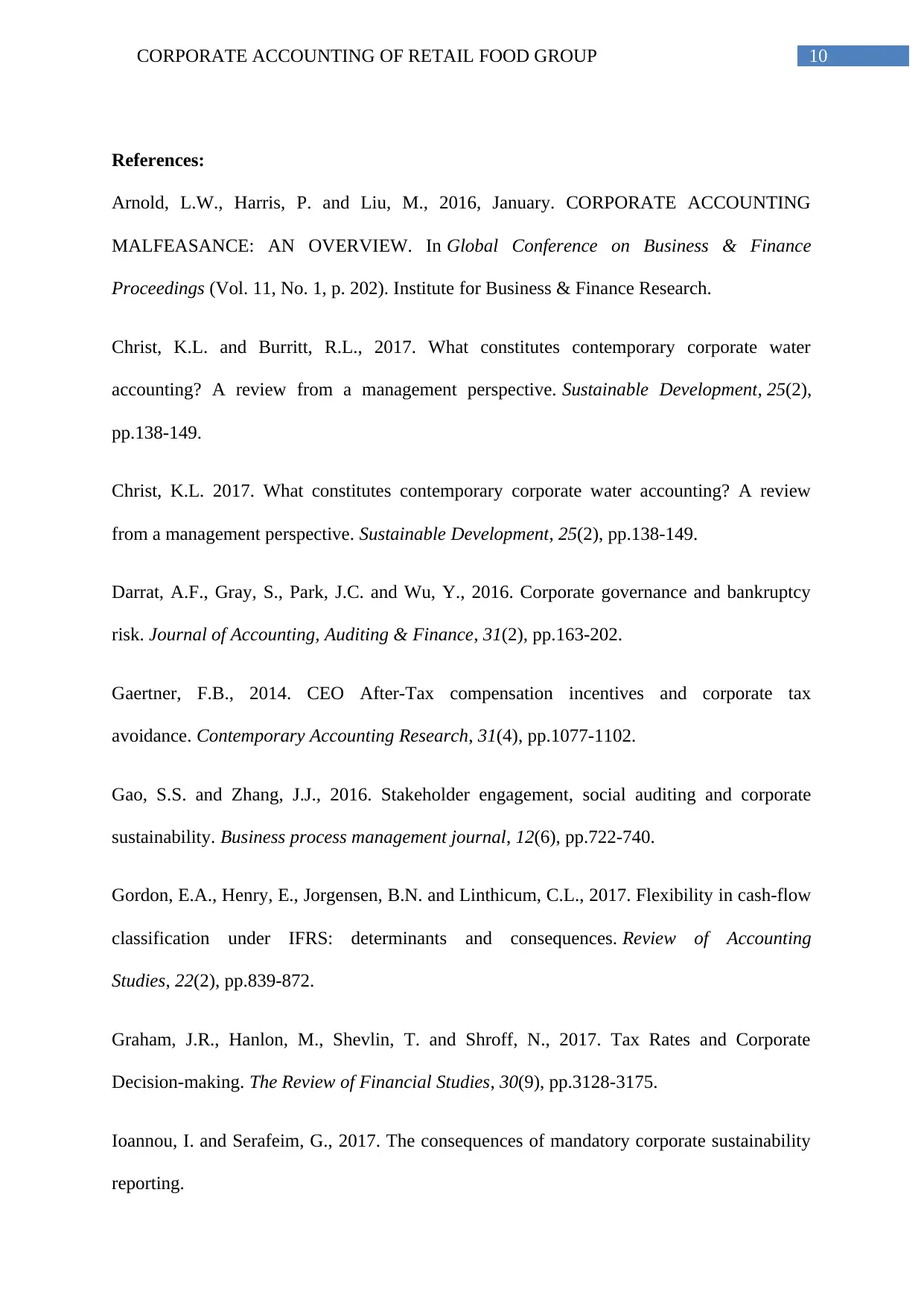
10CORPORATE ACCOUNTING OF RETAIL FOOD GROUP
References:
Arnold, L.W., Harris, P. and Liu, M., 2016, January. CORPORATE ACCOUNTING
MALFEASANCE: AN OVERVIEW. In Global Conference on Business & Finance
Proceedings (Vol. 11, No. 1, p. 202). Institute for Business & Finance Research.
Christ, K.L. and Burritt, R.L., 2017. What constitutes contemporary corporate water
accounting? A review from a management perspective. Sustainable Development, 25(2),
pp.138-149.
Christ, K.L. 2017. What constitutes contemporary corporate water accounting? A review
from a management perspective. Sustainable Development, 25(2), pp.138-149.
Darrat, A.F., Gray, S., Park, J.C. and Wu, Y., 2016. Corporate governance and bankruptcy
risk. Journal of Accounting, Auditing & Finance, 31(2), pp.163-202.
Gaertner, F.B., 2014. CEO After‐Tax compensation incentives and corporate tax
avoidance. Contemporary Accounting Research, 31(4), pp.1077-1102.
Gao, S.S. and Zhang, J.J., 2016. Stakeholder engagement, social auditing and corporate
sustainability. Business process management journal, 12(6), pp.722-740.
Gordon, E.A., Henry, E., Jorgensen, B.N. and Linthicum, C.L., 2017. Flexibility in cash-flow
classification under IFRS: determinants and consequences. Review of Accounting
Studies, 22(2), pp.839-872.
Graham, J.R., Hanlon, M., Shevlin, T. and Shroff, N., 2017. Tax Rates and Corporate
Decision-making. The Review of Financial Studies, 30(9), pp.3128-3175.
Ioannou, I. and Serafeim, G., 2017. The consequences of mandatory corporate sustainability
reporting.
References:
Arnold, L.W., Harris, P. and Liu, M., 2016, January. CORPORATE ACCOUNTING
MALFEASANCE: AN OVERVIEW. In Global Conference on Business & Finance
Proceedings (Vol. 11, No. 1, p. 202). Institute for Business & Finance Research.
Christ, K.L. and Burritt, R.L., 2017. What constitutes contemporary corporate water
accounting? A review from a management perspective. Sustainable Development, 25(2),
pp.138-149.
Christ, K.L. 2017. What constitutes contemporary corporate water accounting? A review
from a management perspective. Sustainable Development, 25(2), pp.138-149.
Darrat, A.F., Gray, S., Park, J.C. and Wu, Y., 2016. Corporate governance and bankruptcy
risk. Journal of Accounting, Auditing & Finance, 31(2), pp.163-202.
Gaertner, F.B., 2014. CEO After‐Tax compensation incentives and corporate tax
avoidance. Contemporary Accounting Research, 31(4), pp.1077-1102.
Gao, S.S. and Zhang, J.J., 2016. Stakeholder engagement, social auditing and corporate
sustainability. Business process management journal, 12(6), pp.722-740.
Gordon, E.A., Henry, E., Jorgensen, B.N. and Linthicum, C.L., 2017. Flexibility in cash-flow
classification under IFRS: determinants and consequences. Review of Accounting
Studies, 22(2), pp.839-872.
Graham, J.R., Hanlon, M., Shevlin, T. and Shroff, N., 2017. Tax Rates and Corporate
Decision-making. The Review of Financial Studies, 30(9), pp.3128-3175.
Ioannou, I. and Serafeim, G., 2017. The consequences of mandatory corporate sustainability
reporting.
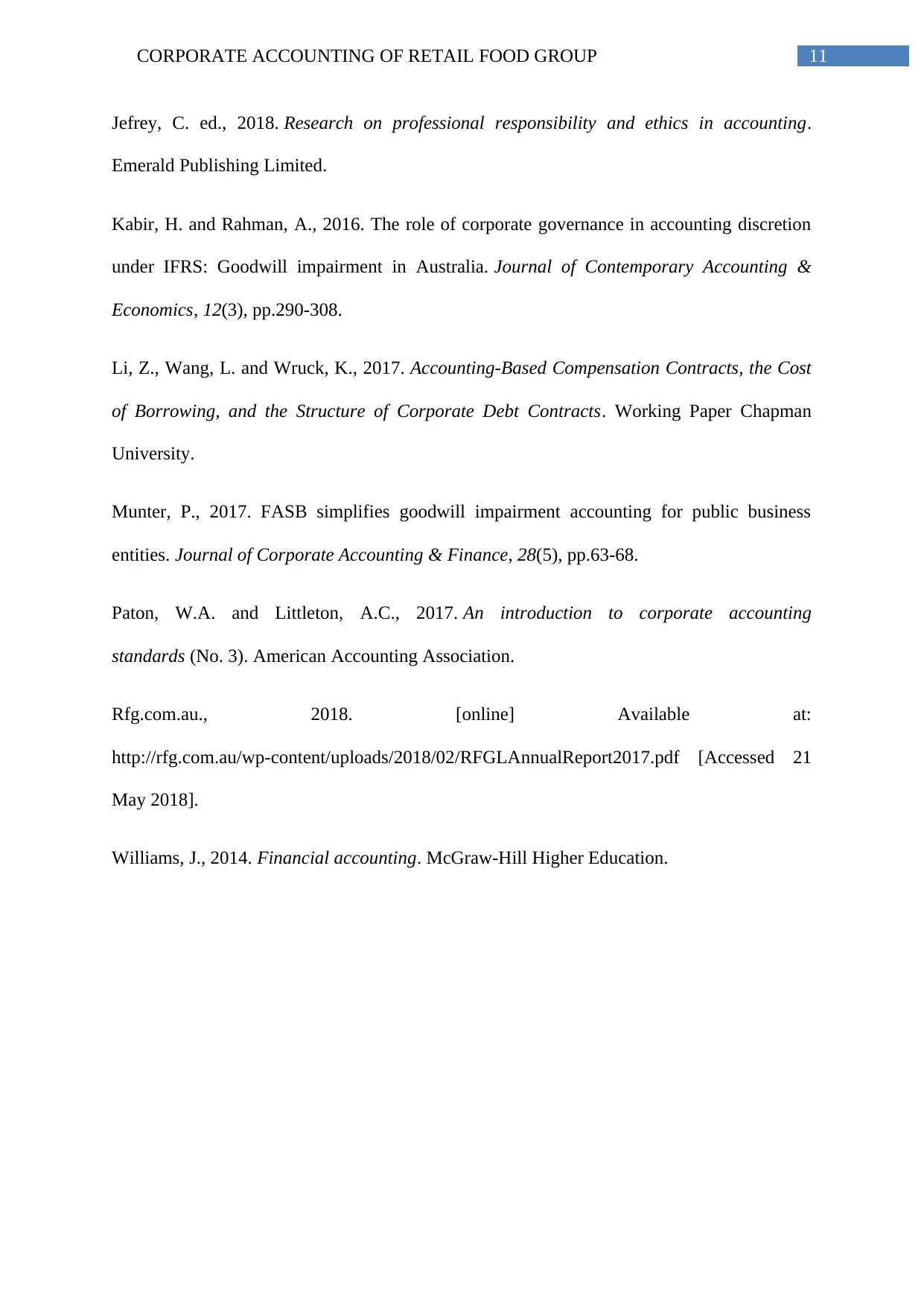
11CORPORATE ACCOUNTING OF RETAIL FOOD GROUP
Jefrey, C. ed., 2018. Research on professional responsibility and ethics in accounting.
Emerald Publishing Limited.
Kabir, H. and Rahman, A., 2016. The role of corporate governance in accounting discretion
under IFRS: Goodwill impairment in Australia. Journal of Contemporary Accounting &
Economics, 12(3), pp.290-308.
Li, Z., Wang, L. and Wruck, K., 2017. Accounting-Based Compensation Contracts, the Cost
of Borrowing, and the Structure of Corporate Debt Contracts. Working Paper Chapman
University.
Munter, P., 2017. FASB simplifies goodwill impairment accounting for public business
entities. Journal of Corporate Accounting & Finance, 28(5), pp.63-68.
Paton, W.A. and Littleton, A.C., 2017. An introduction to corporate accounting
standards (No. 3). American Accounting Association.
Rfg.com.au., 2018. [online] Available at:
http://rfg.com.au/wp-content/uploads/2018/02/RFGLAnnualReport2017.pdf [Accessed 21
May 2018].
Williams, J., 2014. Financial accounting. McGraw-Hill Higher Education.
Jefrey, C. ed., 2018. Research on professional responsibility and ethics in accounting.
Emerald Publishing Limited.
Kabir, H. and Rahman, A., 2016. The role of corporate governance in accounting discretion
under IFRS: Goodwill impairment in Australia. Journal of Contemporary Accounting &
Economics, 12(3), pp.290-308.
Li, Z., Wang, L. and Wruck, K., 2017. Accounting-Based Compensation Contracts, the Cost
of Borrowing, and the Structure of Corporate Debt Contracts. Working Paper Chapman
University.
Munter, P., 2017. FASB simplifies goodwill impairment accounting for public business
entities. Journal of Corporate Accounting & Finance, 28(5), pp.63-68.
Paton, W.A. and Littleton, A.C., 2017. An introduction to corporate accounting
standards (No. 3). American Accounting Association.
Rfg.com.au., 2018. [online] Available at:
http://rfg.com.au/wp-content/uploads/2018/02/RFGLAnnualReport2017.pdf [Accessed 21
May 2018].
Williams, J., 2014. Financial accounting. McGraw-Hill Higher Education.
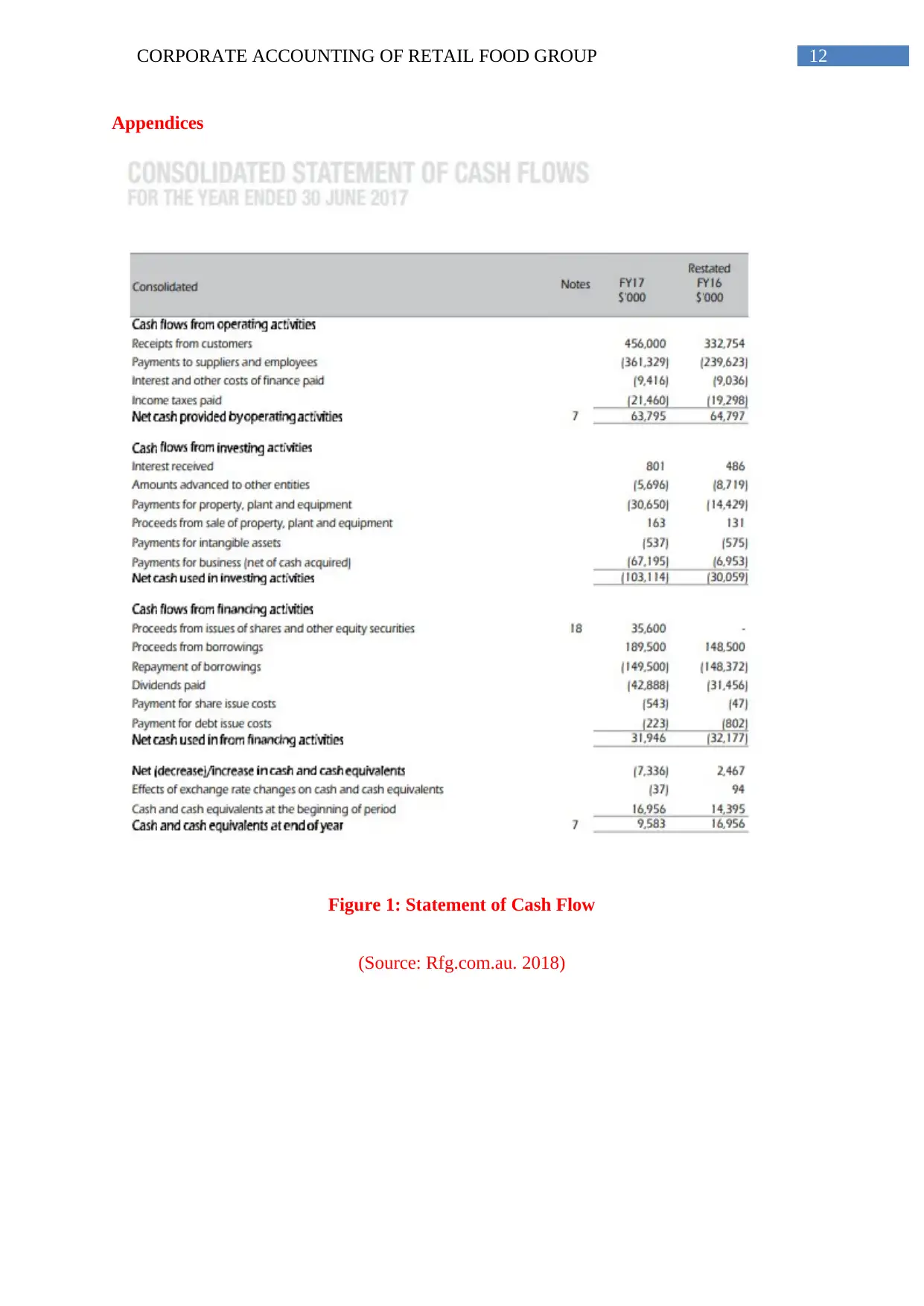
12CORPORATE ACCOUNTING OF RETAIL FOOD GROUP
Appendices
Figure 1: Statement of Cash Flow
(Source: Rfg.com.au. 2018)
Appendices
Figure 1: Statement of Cash Flow
(Source: Rfg.com.au. 2018)
Paraphrase This Document
Need a fresh take? Get an instant paraphrase of this document with our AI Paraphraser
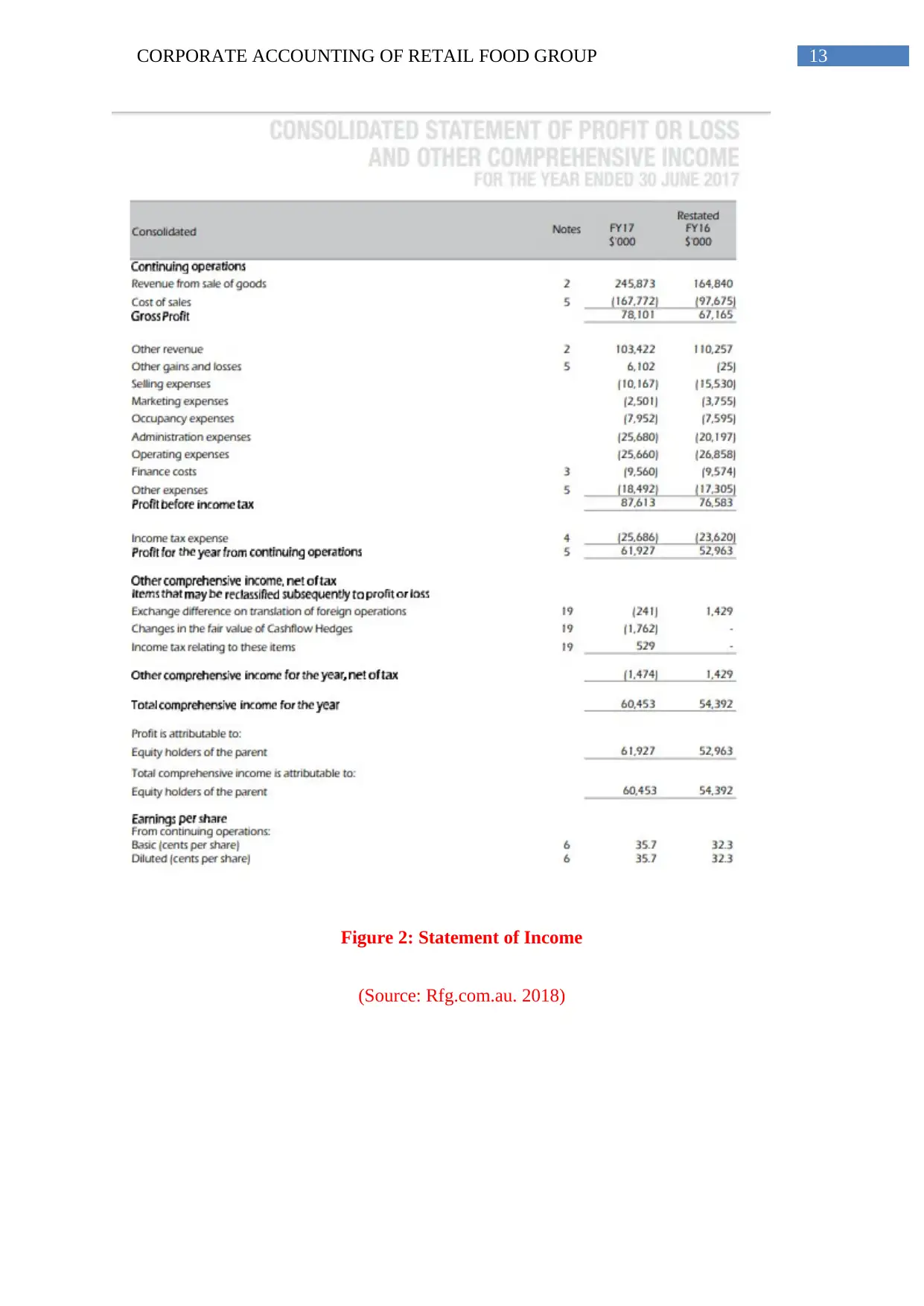
13CORPORATE ACCOUNTING OF RETAIL FOOD GROUP
Figure 2: Statement of Income
(Source: Rfg.com.au. 2018)
Figure 2: Statement of Income
(Source: Rfg.com.au. 2018)

14CORPORATE ACCOUNTING OF RETAIL FOOD GROUP
Figure 3: Balance Sheet
(Source: Rfg.com.au. 2018)
Figure 3: Balance Sheet
(Source: Rfg.com.au. 2018)
1 out of 15
Related Documents
Your All-in-One AI-Powered Toolkit for Academic Success.
+13062052269
info@desklib.com
Available 24*7 on WhatsApp / Email
![[object Object]](/_next/static/media/star-bottom.7253800d.svg)
Unlock your academic potential
© 2024 | Zucol Services PVT LTD | All rights reserved.





